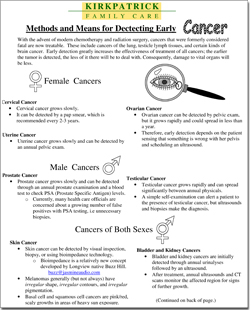Cancer Prevention – Methods and Means for Dectecting Early
· Testicular cancer grows rapidly and can spread significantly between annual physicals.
· A simple self-examination can alert a patient to the presence of testicular cancer, but ultrasounds and biopsies make the diagnosis.
Bladder and Kidney Cancers
· Bladder and kidney cancers are initially detected through annual urinalyses followed by an ultrasound.
· After treatment, annual ultrasounds and CT scans monitor the affected region for signs of further growth.
Cancers of Both Sexes
Skin Cancer
· Skin cancer can be detected by visual inspection, biopsy, or using bioimpedance technology.
· Bioimpedance is a relatively new concept developed by Longview native Buzz Hill.
buzz@jasmineaudio.com
· Melanomas generally (but not always) have irregular shape, irregular contours, and irregular pigmentation.
· Basal cell and squamous cell cancers are pink/red, scaly growths in areas of heavy sun exposure.
Uterine Cancer
· Uterine cancer grows slowly and can be detected by an annual pelvic exam.
Male Cancers
Prostate Cancer
· Prostate cancer grows slowly and can be detected through an annual prostate examination and a blood test to check PSA (Prostate Specific Antigen) levels.
· Currently, many health care officials are concerned about a growing number of false positives with PSA testing, i.e unnecessary biopsies.
Female Cancers
Ovarian Cancer
· Ovarian cancer can be detected by pelvic exam, but it grows rapidly and could spread in less than a year.
· Therefore, early detection depends on the patient sensing that something is wrong with her pelvis and scheduling an ultrasound.
Cervical Cancer
· Cervical cancer grows slowly.
· It can be detected by a pap smear, which is recommended every 2-3 years.
With the advent of modern chemotherapy and radiation surgery, cancers that were formerly considered fatal are now treatable. These include cancers of the lung, testicle lymph tissues, and certain kinds of brain cancer. Early detection greatly increases the effectiveness of treatment of all cancers; the earlier the tumor is detected, the less of it there will be to deal with. Consequently, damage to vital organs will be less.
Imaging Detection
· Colon cancer can also be detected with CT scans through a process known as virtual colonoscopy or CT colonography.
· Some studies have shown this to be as specific as colonoscopy, but it is highly dependent on factors such as staff, equipment, etc
Colon Cancer
Physical Detection
· Rectal bleeding is one of the primary indicators of colon cancer along with black-colored stool (“melena”), and changes in bowel movements in terms of size and frequency.
· Periodic scoping can detect the cancer in early stages.
· An annual stool check can also aid in early detection.
· CEA (CarcinoEmbryonic Antigen) blood tests, used to detect tumors, are no longer considered reliable.
Handout compiled by Adam Heuett: aheuett@up.edu
Breast Cancer
· Although breast cancer usually occurs in women, men can develop it also.
· This form of cancer can be detected by mammograms, ultrasounds, and/or MRIs.
· If a lump is found, an examination of the lump is required with a possible biopsy, even if the mammogram shows normal results.
Lung Cancer
· X-rays, CT, PET and scans can detect lung cancer.
· Studies of 30 years ago showed that early detection did not increase a patient’s chance of survival with this type of cancer. With the increased effectiveness of chemotherapy, radiation, and surgery, however, early detection makes sense statistically.
The Future of Cancer Detection
In the near future, whole-body MRI, CT, and PET scans will most likely detect almost every form of developing cancer in the organs of the chest and abdomen. Currently, such methods are very expensive, costing thousands of dollars, but their percent of positives on people without symptoms is incredibly low. Thus, for the present, doctors recommend NOT obtaining these studies unless specific symptoms raise the suspicion of cancer.
Miscellaneous Cancers
· Most other forms of cancer can be detected with a complete physical examination. Please bear in mind that you may be asked about several different symptoms during a physical, some of which may seem minor but could be warning signs to the doctor, who would then order lab tests specific to certain cancers.
Patients should receive complete physical examinations based on these guidelines:
o Three times in their 30’s.
o Four times in their 40’s.
o Five times in their 50’s.
o Annually past the age of 60.
Tags: cancer
